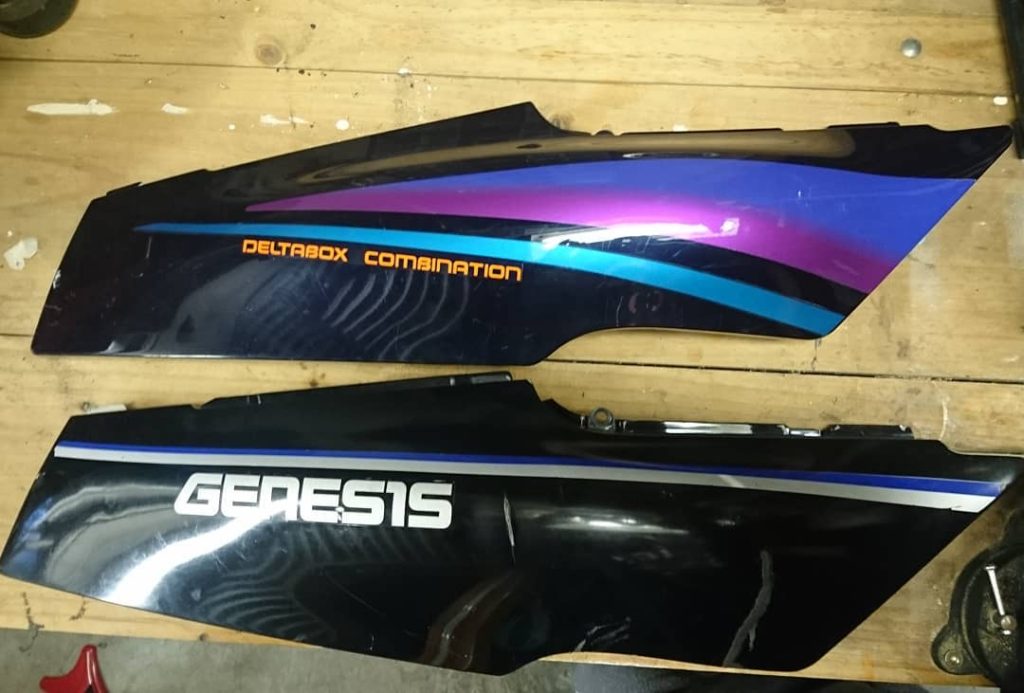While recovering from the shock of the ‘you need a new engine’ news, navigating the appropriate government department processes required to get an interstate, unregistered bike re-registered and generally panicking about the whole thing, a wonderful beast appeared on the horizon – that wonderful thing called a ‘parts bike’.
It was a 1992 I believe, and located in suburban Victoria, which is ‘only’ 800km from Adelaide – a one-way day trip in Australian terms (with an obligatory lunchtime stop at Bordertown for a pie and a kick of the footy).
Or at least that’s what it seemed at a first glance.
The bike was largely complete except minus the motor, which had gone to a go kart from memory. What it did have which was of significant interest was a complete and in very good nick set of rear panels – two side panels and a tail piece. It was missing the side and nose panels, which I had already discovered were as rare as rocking horse poop, but the most obviously damaged ones on my bike were the side panels, so these were particularly interesting. There were also a plethora of other what looked like very nicely preserved bits – brakes, forks, wheels, electrics, and of course the frame.
And here’s where things get messy.
As I had discovered when transporting the bike from Tenterfield, transporting bikes across long distances is not a trivial exercise, and this holds true even when the bike is sans-engine. The basics are still the same – the need to transport an awkwardly shaped, 100+kg hunk of metal that may or not be filled with all sorts of fluids from A to B.
This led, in a sense, to an even trickier problem. The whole parts bike was for sale for (from memory) $800, but it would cost half that again to have it transported – possibly more given that it had already been partly dismantled. This made it far less attractive, and yet, those side panels…
All manner of ideas were hatched. Hiring a trailer and taking my elderly BMW across to pick it up (risky and time consuming), hiring a van and driving over (expensive and time consuming), paying to freight the whole thing over (just plain expensive), and even driving a hatchback over, dismantling the bike to get all the good bits off and then somehow disposing of the frame… But none of these seemed like feasible options (although the last one would have been an adventure, even if one that only made sense towards the end of a heavy drinking session – ‘yeah, let’s take the toolbox and angle grinder to Melbourne, that’s be AWESOME’).
In spite of my pleas to the seller to sell me a few bits only, he ended up selling the whole thing to another local buyer, who was mostly after the front end. After asking the original seller to pass on my details to the new owner, I was able to get the panels and a few other random bits and pieces that I could see from the pictures for $270, and thanks to a cousin in Melbourne I was able to have the parts packed up in a box and shipped over to Adelaide for another $25.
The end result? A box arrived on my doorstep with, among other things, three shiny new panels that, although they didn’t match, were at least not cracked all to hell and held on with little more than liquid nails and good luck.
It is worth mentioning at this point the radical changes in styling that appear to have gone on at Yamaha between 1990 and 1992. It can be best summed up by looking at the two panels in the same shot. The bottom one is 1990 – very black, very basic, very serious. Then the ’92 above, looking like the motorbike equivalent of a technicolour shell suit…

Given that a respray was always on the cards to get that ‘1989 look’ (which I’ll discuss in a separate post), the colour of these was unimportant. What was important was that I now had some far more decent (if not matching) plastics in preparation for the motor registration check, which I’ll talk about in the next post.
Next up: Judgement day
